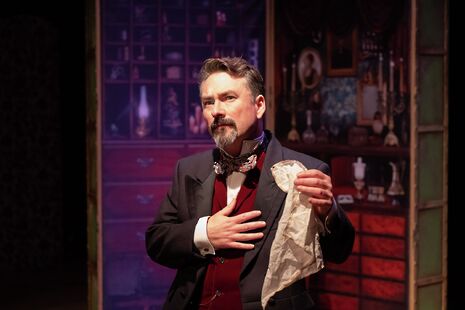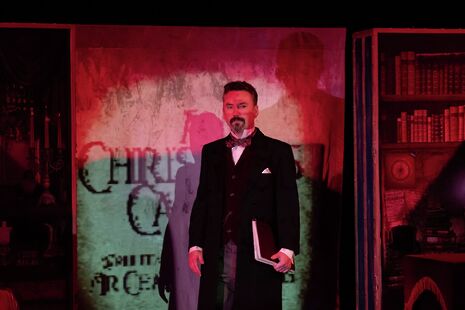Revisiting Dickens reveals modern issues
With ‘Bridgemas’ fast approaching, Priya Edwards talks to actor John O’Connor about his upcoming one-man version of A Christmas Carol raising money for Great Ormond Street
This year marks the 160-year anniversary of Charles Dickens’ visit to Cambridge Town Hall for his reading of A Christmas Carol. It was the first public reading that Dickens gave of his own work and, by all accounts, was hugely successful. Given the beloved status of the story at Christmas time across the UK, it seems fitting that such a reading returns to Cambridge.

Actor John O’Connor is bringing us his one-man reading of A Christmas Carol – the first to use the original script since Dickens – in order to try and capture the essence of the author. He describes the vibrant energy of a man who could never stop; Dickens' own friends begged him not to give public performances and yet his genuine desire to connect with people overcame any of his peers’ reservations. I ask O’Connor about the struggles of creating an authentic recreation of a man with such indelible energy. “The production is very vibrant and colourful,” he explains.
This production does take advantage of the technical capacity of modern theatre whilst still being sensitive to an authentic image. 'Magic lanterns' were an early form of image projector that were widely used in the 19th century to add wonder to theatre and public readings. These days, the theatre's capacity to project is far greater, yet this show still captures the spirit of Dickens' use of magic lanterns in the mid-1800s. This production is also in-keeping with Dickens in the communication with the audience; “every night is different,” says O’Connor, “you are having a direct conversation with the audience and you have to play off the energy of the audience”.
There seems to be an enormous pressure in filling such shoes. Whilst O’Connor seems comfortable with the challenge, he admits that there is always the chance to “screw up someone’s Christmas”. He elaborates: “You want to get it right [...] and there is no hiding place in a one-man show”. O’Connor sees A Christmas Carol as an endlessly adaptable tale, one that people will continue to love for years to come, as it can be reinvented in different ways whilst always epitomising Christmas for many.
However, he does hope that audiences don’t just take away the magic of Christmas. At the heart of A Christmas Carol is a story of goodwill and redemption, yet there is a powerful social critique. Dickens was responding to the horrors to child poverty and the suffering caused of the industrial revolution. O’Connor suggests it is quite a dark tale; one that is a “cry of outrage” and inherently political.
I ask if he feels that Dickens’ politics have any relevance today. O’Connor does not hold back. “Child poverty seems like a Victorian problem for so many of us. Yet with 10 years of austerity, these themes seem very much relevant”. The Child Poverty Action Group reported that in 2017-2018 there were 4.1 million children living in poverty in the UK (https://cpag.org.uk/child-poverty/child-poverty-facts-and-figures), which equates to an average of 9 in every class of 30 children.
O’Connor suggests that A Christmas Carol has many parallels to modern Britain. Scrooge is a banker unwilling to give to those in in need, whilst the Cratchits seem to parallel those with little safety net. He likens the Cratchits to those taking the majority of the hit of austerity: “That there are so many that have to rely on food banks all seems very Victorian”. For O'Conner, it is important that we be aware of the 'darker side' of both this classic story and modern Britain.
In O’Connor’s view, Dickens’ was trying to create a connection with people that went beyond the strict class divides of Victorian society. I ask if he feels theatre has a duty to reach out and engage beyond its traditional audiences. O’Connor seems to feel as if it is a way to bring this connection back, saying that, “particularly with a one-man show, the audience is there to be immersed.” He suggests audiences no longer have the same desire to “sit passively behind a proscenium arch” and argues there is a big movement in theatre to create genuine experiences for the audience. O'Connor wants his audience to take away not only a sense of Christmas cheer, but the feeling that connection with others, in whatever form that may take, is vital.

The production is raising money for Great Ormond Street Hospital, in the spirit of community and warmth that the show explores. ‘People leave the theatre with lots of goodwill, and normally that has nowhere to go,” says O'Connor. As Dickens was an early supporter of the hospital, and early public readings of A Christmas Carol were designed to raise funds, this does seem rather fitting. This production constitutes a satisfying full circle; a one-man reading of Dickens’ original script in a place he performed 160 years ago, to raise money for a cause he championed.
A Christmas Carol will be showing at the Mumford Theatre, Cambridge, on Sunday 1st December at 4pm.
 News / Cambridge study finds students learn better with notes than AI13 December 2025
News / Cambridge study finds students learn better with notes than AI13 December 2025 Features / Should I stay or should I go? Cambridge students and alumni reflect on how their memories stay with them15 December 2025
Features / Should I stay or should I go? Cambridge students and alumni reflect on how their memories stay with them15 December 2025 News / Uni Scout and Guide Club affirms trans inclusion 12 December 2025
News / Uni Scout and Guide Club affirms trans inclusion 12 December 2025 Comment / The magic of an eight-week term15 December 2025
Comment / The magic of an eight-week term15 December 2025 News / Cambridge Vet School gets lifeline year to stay accredited28 November 2025
News / Cambridge Vet School gets lifeline year to stay accredited28 November 2025









